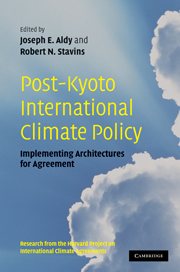Book contents
- Frontmatter
- Contents
- Harvard Environmental Economics Program, International Advisory Board
- Harvard Project on International Climate Agreements, Faculty Steering Committee
- Harvard Project on International Climate Agreements, Project Management
- List of figures
- List of tables
- List of contributors
- Foreword
- 1 Introduction
- Part I Alternative international policy architectures
- Part II Negotiation, assessment, and compliance
- Part III The role and means of technology transfer
- Part IV Global climate policy and international trade
- Part V Economic development, adaptation, and deforestation
- Part VI Modeling impacts of alternative allocations of responsibility
- Part VII Synthesis and conclusion
- Appendix A Selected List of Individuals Consulted, Harvard Project on International Climate Agreements
- Appendix B Workshops and Conferences, Harvard Project on International Climate Agreements
- Glossary and Abbreviations
- Index
Foreword
Published online by Cambridge University Press: 05 June 2012
- Frontmatter
- Contents
- Harvard Environmental Economics Program, International Advisory Board
- Harvard Project on International Climate Agreements, Faculty Steering Committee
- Harvard Project on International Climate Agreements, Project Management
- List of figures
- List of tables
- List of contributors
- Foreword
- 1 Introduction
- Part I Alternative international policy architectures
- Part II Negotiation, assessment, and compliance
- Part III The role and means of technology transfer
- Part IV Global climate policy and international trade
- Part V Economic development, adaptation, and deforestation
- Part VI Modeling impacts of alternative allocations of responsibility
- Part VII Synthesis and conclusion
- Appendix A Selected List of Individuals Consulted, Harvard Project on International Climate Agreements
- Appendix B Workshops and Conferences, Harvard Project on International Climate Agreements
- Glossary and Abbreviations
- Index
Summary
When Charles Keeling began measuring carbon dioxide at Mauna Loa in 1958, the atmospheric concentration was 315 parts per million (ppm). That number represented an increase of 12.5 percent from the pre-industrial level of 280 ppm. Fifty years later, it has reached 385 ppm, and the rate of increase has doubled.
As the Swedish chemist Svante Arrhenius predicted in 1896, those increased levels of carbon dioxide or CO2 are warming the surface temperature of the Earth. The results are evident all around us. The world's tropical belt has expanded toward the poles by two degrees of latitude—as much as had been predicted for the entire 21st century. The Greenland ice sheet, which holds enough water to raise global sea levels by 20 feet, is melting at an accelerated rate. The Arctic Ocean—engine of the Northern Hemisphere's weather—could be ice-free during the summer within five years.
Civilization was built around the climate we have—along coastlines that may be washed away by storms and rising sea levels; around farmland and forests that will become less productive as water supplies diminish; at elevations cool enough to escape insect-borne disease. Changing the climate puts the very organization of modern societies at risk.
We cannot avoid climate change altogether. The effects of our actions are already clear. For all practical purposes, they are irreversible. We can, however, limit the damage, and toward that end, the world must act—urgently, dramatically, and decisively.
- Type
- Chapter
- Information
- Post-Kyoto International Climate PolicyImplementing Architectures for Agreement, pp. xxxiii - xxxviiiPublisher: Cambridge University PressPrint publication year: 2009
- 1
- Cited by



